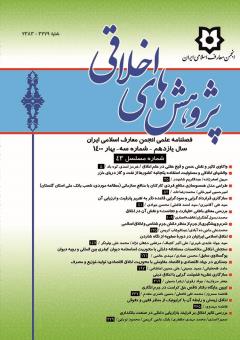طراحی مدل همسوسازی منافع فردی کارکنان با منافع سازمانی (مطالعه موردی: شعب بانک ملی استان گلستان)
محورهای موضوعی : Ethics and Islamic Educationامیر حسین امیرخانی 1 * , محمدرضا تات 2
1 - دانشگاه پیام نور تهران
2 - 0دانشگاه پیام نور، تهران
کلید واژه: همسوسازی, منافع فردی, منافع سازمانی, بانک ملی, استان گلستان,
چکیده مقاله :
هدف تحقیق حاضر طراحی مدل همسوسازی منافع فردی کارکنان با منافع سازمانی در شعب بانک ملی استان گلستان می باشد. روش تحقیق در این مطالعه از نوع آمیخته اکتشافی می باشد. در این پژوهش به دلیل آمیخته بودن روش تحقیق از جهت شناسایی مؤلفه ها و غربال گری توسط روش دلفی از خبرگان مدیریت که دارای تخصص و تجارب مفید و پژوهشهای مرتبط و فعال در حوزه مدیریت منابع انسانی بودهاند، تعداد 20 نفر به روش نمونهگیری گلوله برفی موردبررسی و نظرخواهی قرارگرفته و همچنین برازش مدل بررسی شد. جامعه آماری پژوهش شامل، کلیه کارکنان مدیریت بانک ملی استان گلستان میباشد که حجم این جامعه 98 نفر بوده است. برای بخش کمی تحقیق از روش معادلات ساختاری با استفاده از نرمافزار SMART- PLS استفاده شده است. ابزار گردآوری اطلاعات در این پژوهش پرسشنامه محقق ساخته شاخص های همسوئی منافع فردی و سازمانی می باشد. نتایج نشان داد مهمترین مولفه همسوئی عامل تسهیم اهداف فرد در اهداف سازمان با وزن نسبی 985/0 در رتبه اول و عامل مدیریت بر مبنای ارزشها با وزن نسبی 718/0در آخرین رتبه قرار دارد. همچنین در حالت معناداری بین عوامل ساختاری و رفتاری و فرآیندی و زمینه ای رابطه معناداری وجود دارد.
The aim of the present study is to design a model for aligning the individual-organizational interests in Golestan's Bank Melli Branches. In this study, exploratory sequential mixed method is applied as research approach. This research, due to applying sequential mixed method in terms of identifying components and screening management experts who had outstanding experiences and researches related to the human resource management field, using Delphi Technique, 20 people were investigated and polling conducted through snowball sampling method and also process modeling was done. Statistical population included all the Golestan's Bank Melli employees that were 98 people. Quantitative part was surveyed by using structural equation model and SMART-PLS software. This research enjoys researcher-made questionnaire as a data collection tool for alignment index of individual-organizational interests. The results demonstrate that the most important component is alignment of individuals' goals sharing factor in organization goals with relative weights of 0.985 ranked first and management based on values ranked at the last position with relative weights of 0.718. Also, there is significantly a meaningful relationship between structural, behavioral, process, and contextual factors.
آیات مبارک قرآن کریم
جعفری نیا، شمس الله خیراندیش، مهدی و نجاری، رضا (1385). (سازوکارهای همراستاسازی اهداف فردی و سازمانی به صورت عملیاتی و اجرایی در شرکت فولاد مبارکه اصفهان)، نشریه مطالعات مدیریت صنعتی، شماره14، 1-28.
سید جوادین، سید رضا (1388).برنامه ریزی نیروی انسانی. چاپ چهارم، تهران: انتشارات دانشکده مدیریت دانشگاه تهران.
سید جوادین، سید رضا و پورولی، بهروز (1388). همسوسازی اهداف فردی و سازمانی، مدیریت فرهنگ سازمانی، (20)7، 78-57.
سیدی، سیده رقیه و برزگر، معصومه ( 1391)امر به معروف و نهی از منکر در آثار استاد مطهری، رشد آموزش معارف اسلامی، شماره 12.
Babaei, Tahmours, Qahramani, Massoud and Khalilpour, Kamal. (2013). Factors Affecting the Balance between Individual Objectives and Organizational Objectives, Vol.102, No.8, ResearchPark Journal.
Caker, M., & Siverbo, S., (2014), Strategic Balance in a Decentralized Organization - Svenska Handelsbanken Case, Scandinavian Management Journal, Volume. 30, pp. 149-162.
Escofet, N.C., & Rosanas, J. M. (2013), Designing and Proper Use of Control Control System as Target Compatibility Requirements, Management Accounting Research, Volume. 24, p. 23-40
Feletto, E., Wilson, L. K., Roberts, A. S., Benrimoj, S. I., (2011), Organizational Flexibility Measurement in Community Pharmacy: Creating Capacity to Implement Cognitive Pharmaceutical Services, Research in Social and Administrative Pharmacy, Volume. 7, No. 1: pp. 27-38
Hanson, John D, Melnik Steven. A and Calantone Rojer. A. (2011), Determining and Measuring Balance in Performance Management, Year 31. Issue 10, International Journal of Operation and Production Management.
Kaplan, R., & Norton, D. (2006). Alignment. Boston, M.Sc.: School of Business School Publications.
Kline, R.B. (2010), Principles and Methods of Structural Equation Modeling (Edition 3), New York: Gilford.
Kheirandish Mehdi. (2014), Measuring the Balance of Personal and Organizational Objectives: Preparing a Practical Model, Volume. 3 (2), Journal of New Science Research.
Lepmets, M., McBride, T., & Ras, E., (2012), Impression in the Goal alignment, Journal of Systems and Software, Vol. 85, p. 1440-1452.
Nizar Albujian and Patrick Liu. (2012), Best Strategies for Coordinating Employees with Organizational Objectives, http: //www.irl.cornell.edu.
Ramezani, Y. Boromand, N. (2013), Factors and Roots of Administrative Corruption from an Islamic Perspective, Journal of Innovative Ideas.
Scott, Edinger (2013), the power of alignment creates a common ground for team goals. Web site: Web: www.jostle.me.
Sripirabaa, B., & Krishnaveni, R., (2010), Performance Management Systems in the Indian Production Sector: Participation, Monetary Incentives and Balancing Organizational Objectives, Management Research News, Volume. 32, p. 942 - 952.
Wallace, CJ, Johnson, PD, Mathe, K., Powell, Jay. , (2011), Structural Psychological Empowerment Structures, Performance, and the Role of Shared Response Shared Emotion: A Management Perspective, Journal of Applied Psychology, Volume 96, Number 4, pp. 840-850.
Jan Zhang and Chi-Yu Chiu (2011) predict the goal commitment and alignment of personalities to predict group identity only if the goals are shared.

